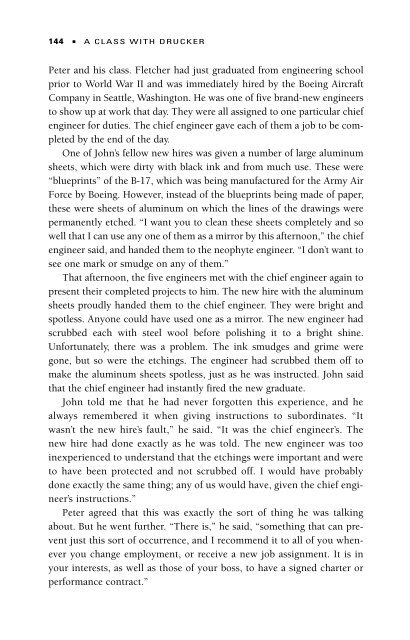A Class with Drucker - Headway | Work on yourself
A Class with Drucker - Headway | Work on yourself
A Class with Drucker - Headway | Work on yourself
Create successful ePaper yourself
Turn your PDF publications into a flip-book with our unique Google optimized e-Paper software.
144 ■ A CLASS WITH DRUCKER<br />
Peter and his class. Fletcher had just graduated from engineering school<br />
prior to World War II and was immediately hired by the Boeing Aircraft<br />
Company in Seattle, Washingt<strong>on</strong>. He was <strong>on</strong>e of five brand-new engineers<br />
to show up at work that day. They were all assigned to <strong>on</strong>e particular chief<br />
engineer for duties. The chief engineer gave each of them a job to be completed<br />
by the end of the day.<br />
One of John’s fellow new hires was given a number of large aluminum<br />
sheets, which were dirty <str<strong>on</strong>g>with</str<strong>on</strong>g> black ink and from much use. These were<br />
“blueprints” of the B-17, which was being manufactured for the Army Air<br />
Force by Boeing. However, instead of the blueprints being made of paper,<br />
these were sheets of aluminum <strong>on</strong> which the lines of the drawings were<br />
permanently etched. “I want you to clean these sheets completely and so<br />
well that I can use any <strong>on</strong>e of them as a mirror by this afterno<strong>on</strong>,” the chief<br />
engineer said, and handed them to the neophyte engineer. “I d<strong>on</strong>’t want to<br />
see <strong>on</strong>e mark or smudge <strong>on</strong> any of them.”<br />
That afterno<strong>on</strong>, the five engineers met <str<strong>on</strong>g>with</str<strong>on</strong>g> the chief engineer again to<br />
present their completed projects to him. The new hire <str<strong>on</strong>g>with</str<strong>on</strong>g> the aluminum<br />
sheets proudly handed them to the chief engineer. They were bright and<br />
spotless. Any<strong>on</strong>e could have used <strong>on</strong>e as a mirror. The new engineer had<br />
scrubbed each <str<strong>on</strong>g>with</str<strong>on</strong>g> steel wool before polishing it to a bright shine.<br />
Unfortunately, there was a problem. The ink smudges and grime were<br />
g<strong>on</strong>e, but so were the etchings. The engineer had scrubbed them off to<br />
make the aluminum sheets spotless, just as he was instructed. John said<br />
that the chief engineer had instantly fired the new graduate.<br />
John told me that he had never forgotten this experience, and he<br />
always remembered it when giving instructi<strong>on</strong>s to subordinates. “It<br />
wasn’t the new hire’s fault,” he said. “It was the chief engineer’s. The<br />
new hire had d<strong>on</strong>e exactly as he was told. The new engineer was too<br />
inexperienced to understand that the etchings were important and were<br />
to have been protected and not scrubbed off. I would have probably<br />
d<strong>on</strong>e exactly the same thing; any of us would have, given the chief engineer’s<br />
instructi<strong>on</strong>s.”<br />
Peter agreed that this was exactly the sort of thing he was talking<br />
about. But he went further. “There is,” he said, “something that can prevent<br />
just this sort of occurrence, and I recommend it to all of you whenever<br />
you change employment, or receive a new job assignment. It is in<br />
your interests, as well as those of your boss, to have a signed charter or<br />
performance c<strong>on</strong>tract.”


